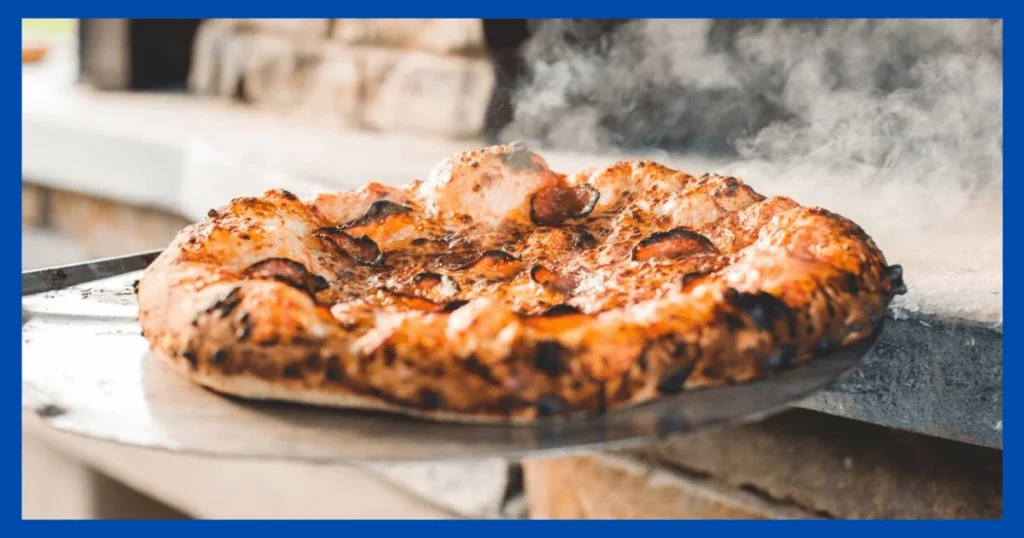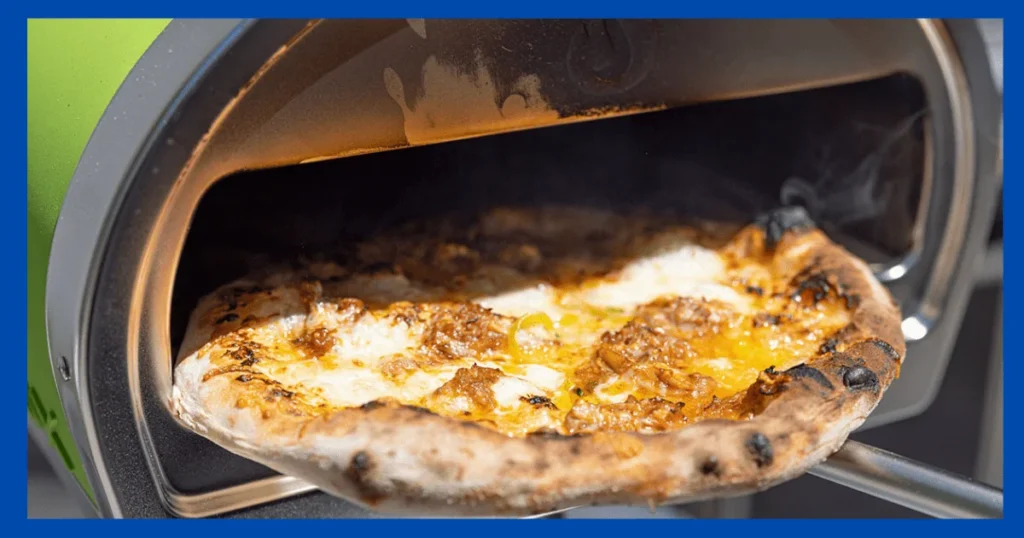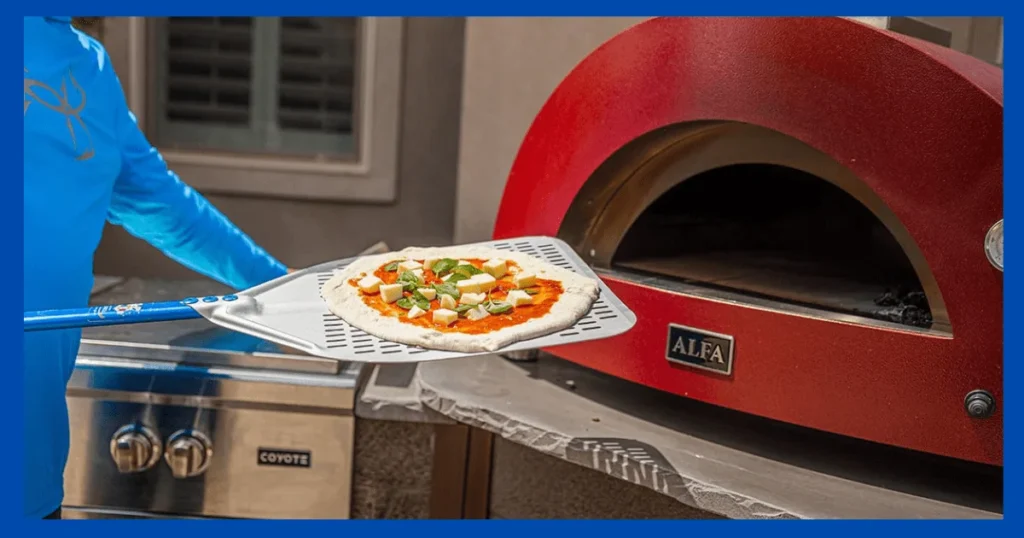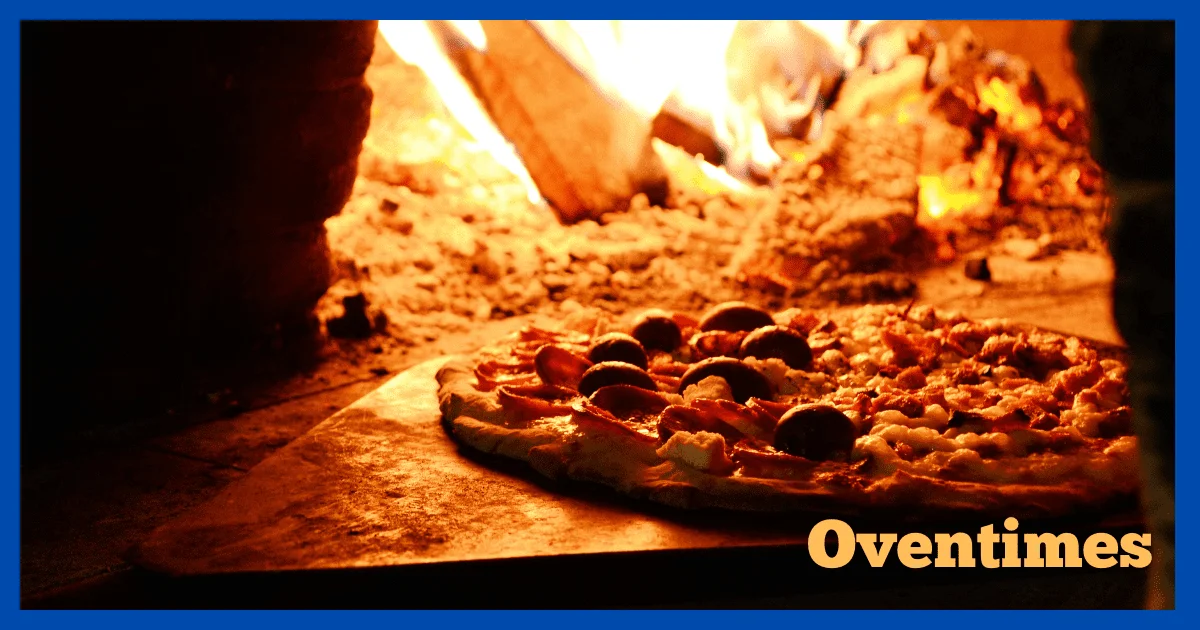A pizza oven reaches extremely high temperatures in order to quickly cook pizza and provide it with that authentic wood-fired taste and texture.
But just how hot does a pizza oven get? The exact temperature depends on the type of pizza oven and factors like the kind of fuel used and how it’s operated.
In this comprehensive guide, we’ll explore the various kinds of pizza ovens and the temperatures they reach, along with tips for getting the most out of your oven.
What Temperature is Ideal for Baking Pizza?

When it comes to baking the perfect pizza, temperature is a crucial factor. The ideal temperature for pizza ovens ranges between 700-900°F (371-482°C).
At these high temperatures, the pizza cooks quickly, in 2-3 minutes, allowing the crust to bake up crisp and the cheese and toppings to melt without overcooking.
The intense heat from the oven floor and walls sears the bottom of the pizza, giving it that coveted char while cooking the top at the same time.
What Are the Different Types of Pizza Ovens and Their Temperature Ranges?
There are several different types of pizza ovens, each with their own temperature capabilities. Here is a breakdown of the common pizza oven varieties and their typical temperature ranges:
Wood-Fired Pizza Oven
- Temperature range: 700-1000°F (371-538°C)
- Fueled by wood, such as oak, maple and hickory
- Requires preheating for 1-2 hours to reach full temperature
- Extremely high temperatures and an oven floor made of brick or stone
- Provides authentic pizza with a crispy charred crust
Gas Pizza Oven
- Temperature range: 500-700°F (260-371°C)
- Heated by propane or natural gas flame
- Reaches cooking temperature much faster than wood-fired, in about 15-20 minutes
- Does not get as hot as wood-fired but still adequate for pizza
- Provides convenience of gas without need to manage a wood fire
Electric Pizza Oven
- Temperature range: 300-650°F (149-343°C)
- Heated by electric heating elements
- Typically reaches desired temperature in 15-30 minutes
- Temperature is adjustable and easy to control
- Does not get as hot as wood or gas ovens but can still make quality pizza
Pizza Oven Appliance
- Temperature range: 400-500°F (204-260°C)
- Built-in home pizza ovens or standalone electric countertop models
- Plug into standard electrical outlet
- Fast preheat time of around 15 minutes
- Lowest temperatures of standard pizza ovens but still hot enough for pizza
As you can see, each type of pizza oven has its own temperature capabilities, which determines how quickly and efficiently it can bake pizza. Wood-fired ovens reach the highest temperatures, followed by gas, electric, and lastly pizza oven appliances.
How Does Temperature Vary Across Different Parts of the Pizza Oven?
The temperature inside a pizza oven is not completely uniform. Here is how it differs across the various areas:
- Oven floor – The floor or stone surface where the pizza cooks is the hottest part, reaching temperatures up to 1000°F (538°C) in wood-fired ovens. This is where the pizza gets its leopard spotted crust.
- Oven ceiling – The ceiling or dome is the next hottest area, reaching 700-900°F (371-482°C). The top heat helps melt and brown the cheese and toppings.
- Oven door – The temperature by the oven door is much cooler, around 300-500°F (149-260°C). This allows loading and turning the pizza without burning yourself.
- Flue vent – The flue vent where smoke exits is around 200-400°F (93-204°C). Necessary for ventilation but not intended for cooking area.
The intense floor and ceiling heat are key for rapid pizza cooking while the lower door and vent temperatures allow access and air flow. Getting to know the temperature zones helps make the most of the oven’s design.
What Factors Influence the Temperature of the Pizza Oven?

There are several variables that impact how hot a pizza oven gets during operation:
- Fuel source – The fuel type (wood, gas, electricity) dictates the maximum potential temperature. Wood-fired ovens reach higher temperatures than gas or electric.
- Oven design – Shape, insulation, materials, and other design factors affect heat retention and circulation. Well-designed ovens hold and spread heat more effectively.
- Quantity of fuel – More wood or higher gas burner output results in higher oven temperatures. The fuel quantity can be increased or throttled to control temperature.
- Ventilation – The flue opening size and ventilation controls allow heat retention to be regulated. More airflow cools the oven temperature.
- Additives – Some oven operators use hardwood chunks or additives like olive and bamboo to boost heat. These can spike temperatures in wood-fired ovens.
- Preheat time – Longer preheat times allow the oven to gradually come up to the full target temperature. Rushing the preheat can result in lower peak temps.
- Opening door – Heat is lost every time the oven door is opened to turn or remove pizzas. Minimizing door open time helps maintain interior temperatures.
With proper attention to these factors, you can achieve your ideal temperature range for baking the perfect pizza.
How Hot is the Floor of a Pizza Oven?
The oven floor reaches the highest temperatures in a pizza oven. In wood-fired brick or stone ovens, the floor can reach up to 1000°F (538°C) when fully preheated. Gas and electric ovens may only get up to 700°F (371°C) on the floor.
The intense bottom heat gives the pizza crust those coveted char marks while rapidly cooking the bottom. Oven floor materials like stone or tile hold and radiate heat evenly across the surface for consistent results across pizzas. Getting the floor hot enough is key to proper crust and leopard spot formation.
How Hot is the Ceiling of a Pizza Oven?
While not quite as hot as the floor, the oven ceiling or dome still gets very hot, generally 700-900°F (371-482°C) for wood-fired ovens. Electric and gas ovens may be closer to 500-700°F (260-371°C) on the ceiling.
The dome radiates heat down over the top of the pizza to melt and brown the cheese and other toppings. A hot ceiling ensures the pizza is cooked from both directions for fast, even results. Proper oven ceiling insulation holds in the heat for best cooking conditions.
How Long Does it Take a Pizza Oven to Reach Cooking Temperature?
The time it takes a pizza oven to fully preheat to cooking temperature depends on the oven type:
- Wood-fired oven – 45-90 minutes or more, requires starting and maintaining a wood fire.
- Gas oven – 15-20 minutes typically. Gas burns instantly so less warm-up needed.
- Electric oven – 15-30 minutes usually. Heating elements heat rapidly.
- Pizza oven appliance – 10-15 minutes. Smaller units preheat quickly.
Wood-fired ovens need the longest preheat times due to slowly building up the wood fire but reach the highest heat. Gas and electric ovens preheat more rapidly thanks to instant-on heating from the burners or elements. Getting the right preheat time allows the oven to stabilize at your target cooking temperature.
Should You Pre-Heat a Pizza Stone or Steel?
Pizza stones and steels are excellent for crisping up crusts, but unlike the oven itself, they do not require lengthy pre-heating. Here are some tips:
- For pizza stones, you only need 10-15 minutes of preheat time in the already hot oven. This allows them to gradually come up to temperature without cracking.
- Pizza steels heat up almost instantly once placed in the hot oven so require no preheating time. Their high conductivity lets them reach cooking temp in just minutes.
- If you forget to preheat your pizza stone, don’t worry! You can place it in the hot oven while it’s already cooking. Just give it a few extra minutes before adding the pizza.
- Make sure to heat stones and steels gradually to prevent damage from thermal shock. Remove them from the oven to cool before cleaning.
With just a brief preheat, pizza stones and steels do their job of crisping the bottom crust without overcooking the toppings. Get your oven hot first, then add these accessories.
Tips for Getting Your Pizza Oven to the Right Temperature
Achieving and maintaining the ideal pizza oven temperature takes some finesse. Here are tips for getting your oven hot enough for perfect pizzas:
How Do You Control the Temperature in a Wood-Fired Pizza Oven?
With wood-fired ovens, temperature control is a matter of managing your fire through the following methods:
- Add more or less wood to raise or lower the temperature as needed. Hardwoods like oak and hickory burn the hottest.
- Adjust the oven flue to allow more or less airflow. More air flow cools the oven while restricting it retains heat.
- Let the fire burn down after cooking for a natural cool down period. Don’t add more wood if the temperature is already high enough.
- Move coals and wood around for more even heat distribution depending on your airflow setup.
- Use a thermometer or thermal imaging camera to monitor temperatures if needed.
- Install adjustable vents or dampers if your oven lacks them. This gives you precision airflow control.
With practice, you’ll get a feel for controlling your fire through intuition and subtle adjustments. Let the oven work for you.
How Do You Regulate Temperature in Gas and Electric Pizza Ovens?
For gas pizza ovens:
- Turn the control knob or dial to adjust the gas burner flame higher or lower as needed.
- Open the door briefly if the oven overheats, then turn down the flame.
- Let the burner run on low after cooking to allow gradual cool down.
For electric pizza ovens:
- Use the built-in thermostat and temperature setting controls.
- Set the target temp then let the elements cycle on/off automatically to maintain it.
- Lower the thermostat if the oven overheats.
The convenience of gas and electric ovens is their precision controls compared to wood-fired ovens. Use them to your advantage.
Should You Use a Pizza Oven Thermometer?
A thermometer is highly recommended for monitoring pizza oven temperatures and calibrating your settings. Look for the following features:
- Dual probes for simultaneously measuring oven floor and ceiling/dome temperatures.
- Remote wireless display so you can monitor it outside the oven.
- High maximum temperature rating of 1000°F or more.
- Programmable alarm to alert when oven has preheated or overheated.
Using a thermometer takes the guesswork out of pizza oven preheating and temperature management. It’s a small investment that pays off in better cooked pizzas.
How Do You Calibrate Your Pizza Oven Temperature?
Performing a calibration procedure ensures your pizza oven thermometer and controls are accurate. Here is a simple process:
- Place oven thermometer probes on the floor and ceiling.
- Close the door and set your desired target temperature on the oven controls.
- Once oven has preheated, check thermometer readings versus set temperature.
- If the thermometer and oven settings disagree, offset the settings until aligned.
- Repeat calibration periodically since temperatures may drift over time.
Calibration accounts for variances between different ovens and thermometers. Don’t rely solely on oven controller numbers for precision cooking.
What Temperature Should You Cook Other Foods in a Pizza Oven?
While designed for pizza, a pizza oven’s high dry heat works wonderfully for cooking many other foods. Recommended cooking temperatures:
- Meats like steaks, chops and chicken – 500-700°F (260-371°C)
- Roasting vegetables – 400-500°F (204-260°C)
- Baking breads and pastries – 350-450°F (177-232°C)
- Smoking brisket, pork, fish – 200-275°F (93-135°C)
Adjust oven temp up or down as needed. The diversity of a pizza oven also makes it perfect for grilling, baking and smoking all kinds of foods. Get creative with your oven’s capabilities!
Can You Get an Oven Too Hot if Preheated for Too Long?
It is possible to overheat your pizza oven with excessive preheating, especially wood-fired ovens. Signs you’ve preheated too long:
- Oven thermometer exceeds maximum temperature rating, usually 1000°F (538°C)
- Oven materials like stone or brick are cracking and crumbling
- Metal surfaces inside are starting to turn red hot and warp
- Smoke and gases are excessively billowing from oven entrance and vents
If you see these warning signs, stop adding fuel to the oven immediately and allow it to cool down. An overheated oven can damage itself and poses a fire hazard as well. learn the limits of your specific oven.
Troubleshooting Common Pizza Oven Temperature Problems
Sometimes pizza ovens fail to heat up properly. Here are some common oven temperature issues and how to fix them:
Oven Won’t Get Hot Enough
Potential Causes:
- Insufficient fuel being burned – Add more wood or turn up gas flame
- Poor airflow through oven – Check for blockages in chimney flue
- Door not sealing properly – Replace worn out door gasket
- Loss of insulation – Fill gaps around oven with new insulation
- Inaccurate thermometer – Double check thermometer against known accurate one
Solutions:
- Provide adequate fuel for the size of the oven
- Clear blockages in flue to increase airflow
- Replace worn out door gasket to seal in heat
- Patch and replace damaged insulation
- Confirm thermometer accuracy or replace if needed
Oven Overheats Easily
Potential Causes:
- Excess fuel burning – Don’t overfill oven with wood or leave gas on high
- Too much airflow – Partially close flue damper or chimney cap
- Failing thermostat – Replace unreliable thermostat
- Inept temperature regulation – Use oven thermometer and adjust
Solutions:
- Control fuel levels and preheat time to avoid overheating
- Adjust flue damper or install one to control airflow
- Replace inaccurate thermostat with a reliable digital one
- Use a thermometer and make incremental temperature adjustments
Uneven Heating Across Oven
Potential Causes:
- Poor oven design – Heat is not well distributed
- Blocked air vents – Even airflow is prevented
- Cold spots from gaps – Missing insulation in places
- Hot spots near heating source – Gas burners aimed wrong spot
Solutions:
- Rotate pizzas during cooking to average out heat differences
- Rearrange interior airflow for better heat distribution
- Add insulation material to fill cold spot gaps
- Redirect or shield gas burner flames away from hot spots
Oven Temperature Fluctuations
Potential Causes:
- Unstable fuel supply – Wood fire growing and ebbing
- Oven door opened frequently – Lets heat escape
- Drafty conditions – Wind impacts ventilation
- Dying heating element – Element cycles on/off
Solutions:
- Maintain steady fuel levels for consistent heat
- Minimize door opening to retain heat
- Shield outdoor oven from wind exposure
- Check heating elements and replace if needed
By identifying the cause of any temperature issues, you can take targeted steps to get your pizza oven heating reliably again.
Safety Tips When Operating a Hot Pizza Oven

Pizza ovens reach extremely high temperatures, so safety is paramount. Follow these precautions:
- Use heat-resistant gloves and tools suited for 500°F+ (260°C+)
- Wear eye protection to safeguard against ash and embers
- Keep children and pets away while oven is hot
- Install sturdy railings if oven is elevated
- Have fire extinguisher on hand in case of flare-ups
- Allow ample clearance from buildings and combustibles
- Place oven on non-flammable surfaces only
- Keep oven exterior surfaces clean to prevent grease fires
- Avoid wearing loose clothing that could catch fire
- Let oven cool fully before cleaning
- Dispose ashes in metal container with lid once completely cooled
Pizza ovens require caution, but following basic safety measures will keep you from harm while enjoying delicious pizza!
Conclusion
Achieving the ideal 700-1000°F (371-538°C) temperature range is imperative for pizza ovens to quickly bake perfect pizza crusts along with melted, browned cheese and toppings.
Wood-fired ovens can reach the hottest temperatures over 1000°F (538°C), while gas and electric ovens typically max out around 700°F (371°C). Factors like fuel type, ventilation, insulation, and preheat time all impact how hot the oven ultimately gets.
Monitoring oven temperature with a high-heat thermometer enables precision cooking. While designed for pizza, these specialty ovens can also be used for cooking meats, vegetables, breads, and more by adjusting the temperature accordingly.
With the right settings and operation, your pizza oven will deliver authentic results and versatile cooking performance. Just be sure to follow safety precautions when running it at super high temperatures. Mastering heat control is the key to success with your pizza oven.
Frequently Asked Questions
Here are some frequently asked questions given below:
How hot does a pizza oven need to be?
700-900°F (371-482°C) is the ideal pizza cooking temperature range for most ovens. Well-designed wood-fired ovens can reach peaks of 1000°F (538°C) on the oven floor. High heat is key for quickly baking the crust while melting the cheese.
What temperature does pizza cook at?
Pizza cooks best around 700-900°F (371-482°C). At this temperature range, the pizza will be done in 2-3 minutes with a crisp crust and melty toppings. Higher heat risks burning the crust before toppings fully cook.
Will a 600 degree oven cook pizza?
Yes, a 600 degree oven will cook pizza. Most pizza recipes call for baking pizza at temperatures between 400-550 degrees Fahrenheit. 600 degrees is on the high end but will still effectively cook pizza and produce a crispy crust. The high heat may burn some toppings and bottoms though, so watch the pizza closely.
What can I cook in my pizza oven?
Pizza ovens can cook far more than just pizza. Their dry ambient heat works great for meats, vegetables, breads, and more. Just adjust the temperature based on the food. Around 500°F (260°C) for meats, 400°F (204°C) for bread/pastries, and 300-400°F (149-204°C) for roasted veggies.
How long does a pizza oven take to heat up?
Heat up times vary:
- Wood-fired ovens: 45-90+ minutes
- Gas ovens: 15-20 minutes
- Electric ovens: 15-30 minutes
- Pizza oven appliances: 10-15 minutes
Wood-fired ovens take the longest due to slowly building the fire. Gas and electric models heat quickly thanks to instant-on burners or elements.
Does pizza taste better in a wood fired oven?
Wood-fired ovens can reach the highest temperatures and impart a light smoky flavor, producing exceptional authentic Neapolitan-style pizza. However, gas and electric ovens can still make delicious pizza with the right technique. It’s more about the overall oven design rather than just using wood as fuel.
Is it safe to cook meat in a pizza oven?
Yes, a pizza oven’s high dry ambient heat makes it perfect for cooking lean meats like steak, chops, chicken, etc. Always use a meat thermometer to ensure foods reach safe internal temperatures. Avoid flare-ups from fatty drippings by placing a foil drip pan under meat. Clean the oven well after cooking meats.
